PONTIAC BONNEVILLE 2003 Repair Manual
Manufacturer: PONTIAC, Model Year: 2003, Model line: BONNEVILLE, Model: PONTIAC BONNEVILLE 2003Pages: 418, PDF Size: 20.24 MB
Page 61 of 418
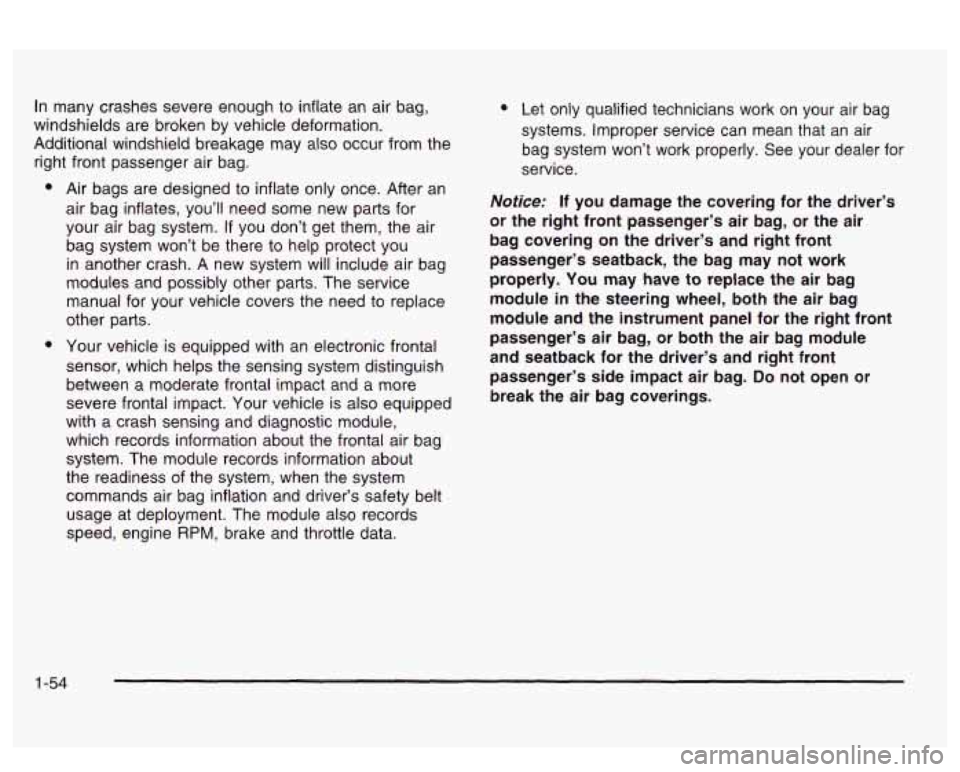
In many crashes severe enough to inflate an air bag,
windshields are broken by vehicle deformation.
Additional windshield breakage may also occur from the
right front passenger air bag.
0 Air bags are designed to inflate only once. After an
air bag inflates, you’ll need some new parts for
your air bag system.
If you don’t get them, the air
bag system won’t be there to help protect you
in another crash.
A new system will include air bag
modules and possibly other parts. The service
manual for your vehicle covers the need to replace
other parts.
Your vehicle is equipped with an electronic frontal
sensor, which helps the sensing system distinguish
between a moderate frontal impact and a more
severe frontal impact. Your vehicle is also equipped
with a crash sensing and diagnostic module,
which records information about the frontal air bag
system. The module records information about
the readiness
of the system, when the system
commands air bag inflation and driver’s safety belt
usage at deployment. The module also records
speed, engine
RPM, brake and throttle data.
0 Let only qualified technicians work on your air bag
systems. Improper service can mean that an air
bag system won’t work properly. See your dealer for
service.
Notice: If you damage the covering for the driver’s
or the right front passenger’s air bag, or the air
bag covering on the driver’s and right front
passenger’s seatback, the bag may not work
properly. You may have to replace the air bag
module in the steering wheel, both the air bag
module and the instrument panel for
the right front
passenger’s air bag, or both the air bag module
and seatback for the driver’s and right front
passenger’s side impact air bag.
Do not open or
break the air bag coverings.
1-54
Page 62 of 418
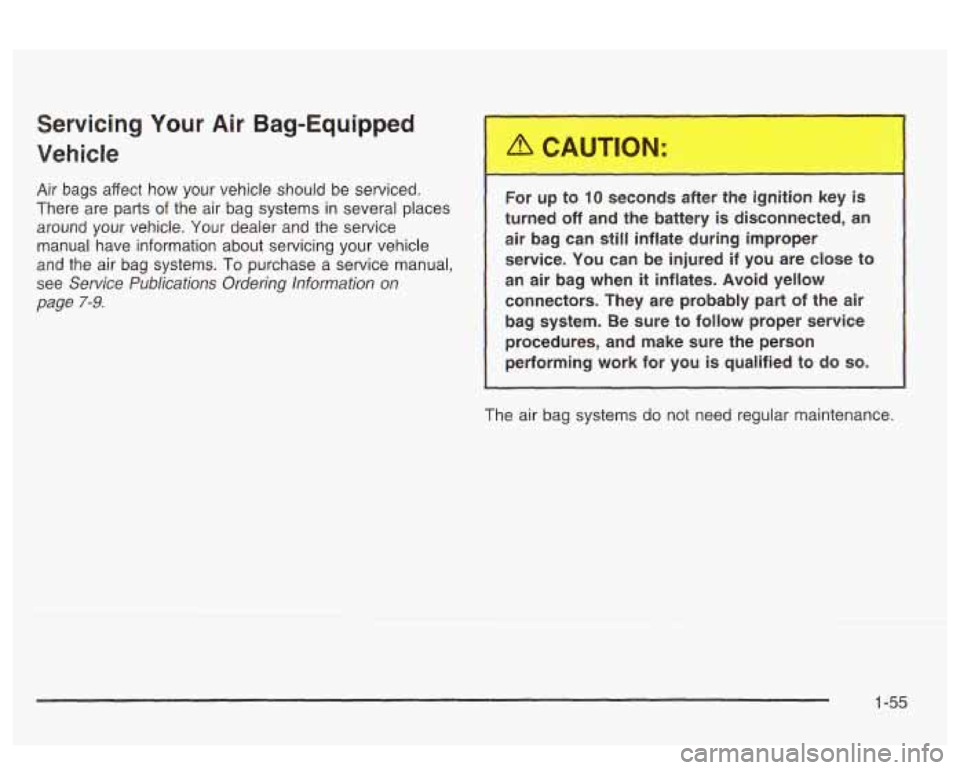
Servicing Your Air Bag-Equipped
Vehicle
Air bags affect how your vehicle should be serviced.
There are parts
of the air bag systems in several places
around your vehicle. Your dealer and the service
manual have information about servicing your vehicle
and the air bag systems. To purchase a service manual,
see
Service Publications Ordering lnformation on
page
7-9.
For up to 10 seconds after the ignition key is
turned
off and the battery is disconnected, an
air bag can still inflate during improper service. You can be injured if you are close to
an air bag when it inflates. Avoid yellow
connectors. They are probably part of the air
bag system. Be sure to follow proper service
procedures, and make sure
the person
performing work for you is qualified to do
so.
The air bag systems do not need regular maintenance.
1-55
Page 63 of 418
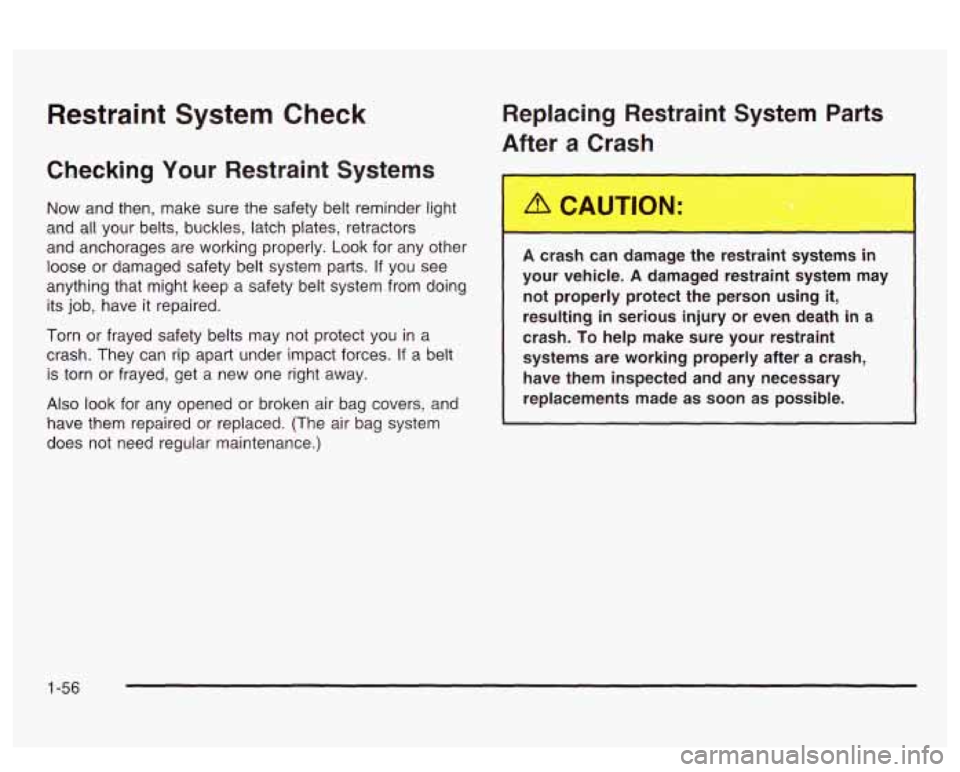
Restraint System Check
Checking Your Restraint Systems Replacing Restraint System Parts
After a Crash
Now and then, make sure the safety belt reminder light
and all your belts, buckles, latch plates, retractors
and anchorages are working properly. Look for any other
loose or damaged safety belt system parts.
If you see
anything that might keep a safety belt system from doing
its job, have it repaired.
Torn or frayed safety belts may not protect you in a
crash. They can rip apart under impact forces.
If a belt
is torn or frayed, get a new one right away.
Also look for any opened or broken air bag covers, and
have them repaired or replaced. (The air bag system
does not need regular maintenance.)
A crash can damage the restraint systems in
your vehicle. A damaged restraint system may
not properly protect the person using
it,
resulting in serious injury or even death in a
crash.
To help make sure your restraint
systems are working properly after a crash, have them inspected and any necessary replacements made as soon as possible.
1 -56
Page 64 of 418
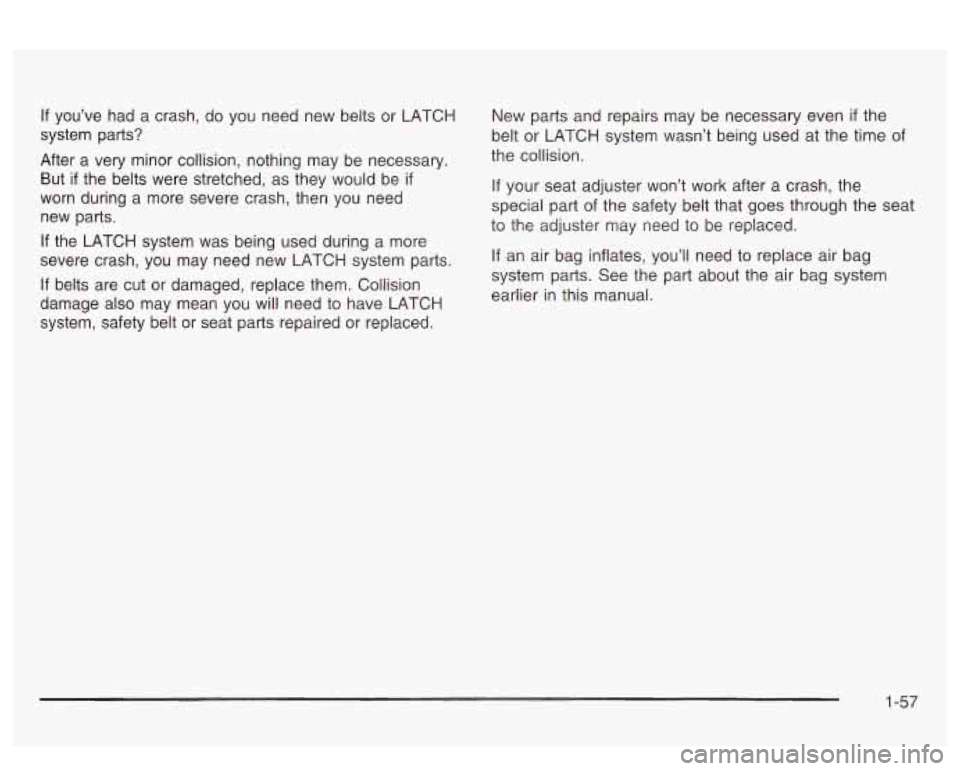
If you’ve had a crash, do you need new belts or LATCH
system parts?
After a very minor collision, nothing may be necessary.
But if the belts were stretched, as they would be
if
worn during a more severe crash, then you need
new parts.
If the LATCH system was being used during a more
severe crash, you may need new LATCH system parts.
If belts are cut or damaged, replace them. Collision
damage also may mean you will need to have LATCH
system, safety belt or seat parts repaired or replaced. New parts
and repairs may be necessary even if the
belt or LATCH system wasn’t being used at the time of
the collision.
If your seat adjuster won’t work after a crash, the
special part of the safety belt that goes through the seat
to the adjuster may need to be replaced.
If an air bag inflates, you’ll need to replace air bag
system parts. See the part about the air bag system
earlier in this manual.
1-57
Page 65 of 418

b NOTES
1-58
Page 66 of 418
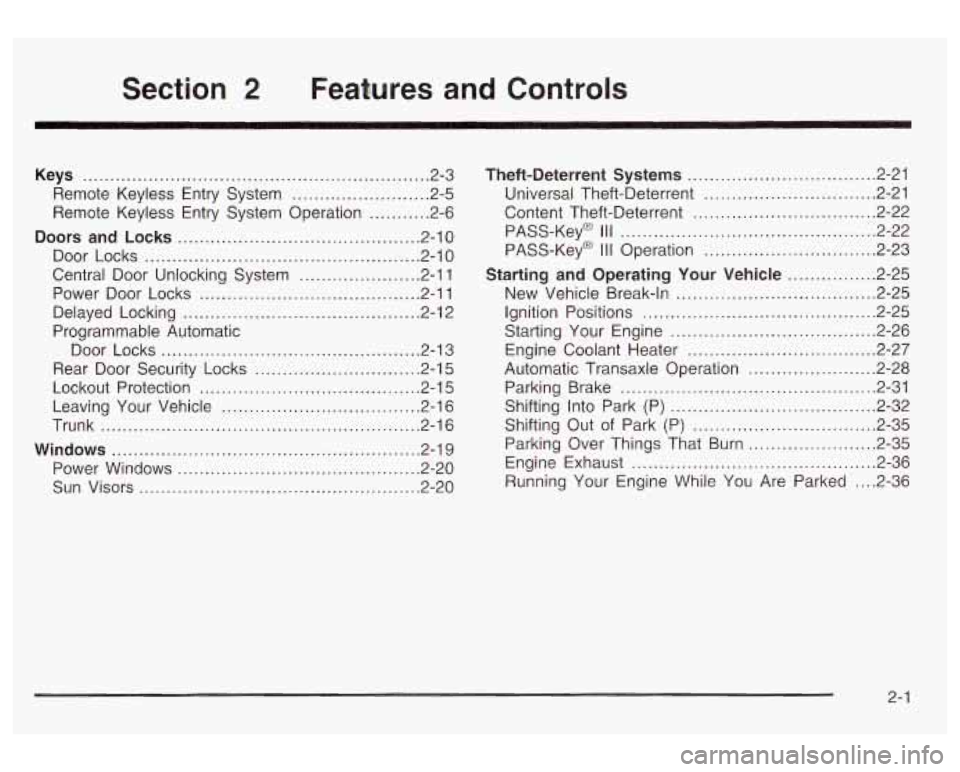
Section 2 Features and Controls
Keys ............................................................... 2.3
Remote Keyless Entry System
......................... 2.5
Remote Keyless Entry System Operation
........... 2.6
Doors and Locks ............................................ 2.10
Door Locks
.................................................. 2.10
Central Door Unlocking System
...................... 2-1 1
Power Door Locks ........................................ 2-11
Programmable Automatic
Delayed Locking
........................................... 2-12
Door Locks
................................. ....... 2-13
Rear Door Security Locks
.............................. 2-15
Lockout Protection
........................................ 2-15
Leaving Your Vehicle
.................................... 2-16
Trunk
.......................................................... 2-16
Windows ........................................................ 2-19
Power Windows
............................................ 2-20
Sun Visors
.......... .............................. 2.20
Theft-Deterrent Systems .................. .... 2.21
Universal Theft-Deterrent
............................... 2.21
Content Theft-Deterrent
................................. 2.22
PASS-Key@
I I I Operation ............................... 2-23
Starting and Operating Your Vehicle ................ 2-25
New Vehicle Break-In
................................... -2-25
Ignition Positions
.......................................... 2-25
Starting Your Engine
.................. ............ 2-26
Engine Coolant Heater
........... ........... -2-27
Automatic Transaxle Operation
....................... 2-28
Parking Brake
.............................................. 2-31
Shifting Into Park (P)
..................................... 2-32
Engine Exhaust
............................................ 2-36
Running Your Engine While You Are Parked
.... 2-36
PASS-Key@
Ill .............................................. 2-22
Shifting Out
of Park (P) ................................. 2-35
Parking Over Things That Burn
....................... 2-35
2-
1
Page 67 of 418

Section 2 Features and Controls
Mirrors .................................................... 2.38
Manual Rearview Mirror
................................. 2.38
Automatic Dimming Rearview Mirror
................ 2.38
Outside Power Mirrors
................................... 2.38
Outside Convex Mirror
................................... 2-39
Outside Heated Mirrors
.................................. 2-39
Onstar@ System ............................................. 2-40
HomeLink@ Transmitter ................................... 2-42
HomeLink@ Transmitter
................................. -2-42
Programming the HomeLink Transmitter
.......... -2-43
Outside
Curb View Assist Mirror
..................... 2-39
Storage Areas ................................................ 2.46
Glove
Box ................................................... 2.46
Front Storage Area
....................................... 2.46
Center Console Storage Area
.. ........... 2.46
Rear Seat Pass Through
........................... 2.46
Convenience Net
.......................................... 2.46
Sunroof ......................................................... 2.47
Vehicle Personalization ................................... 2.48
Memory Seat and Mirrors
.......................... 2.48
2-2
Page 68 of 418
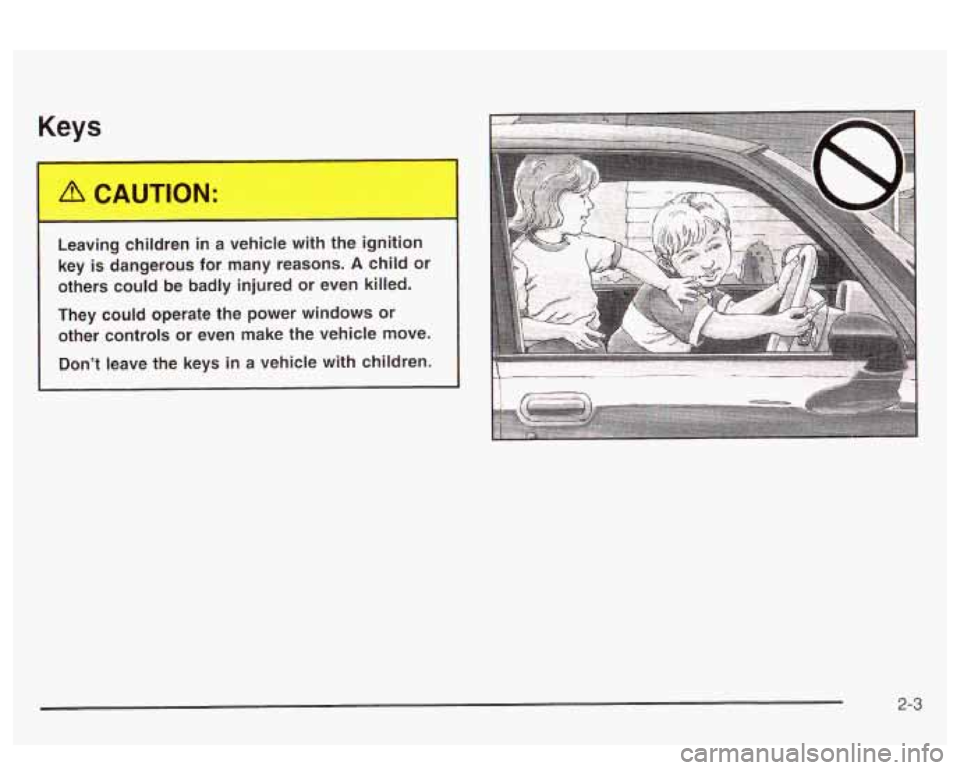
Keys
I
Leaving children in a vehicle with the ignition
key is dangerous for many reasons.
A child or
others could be badly injured or even killed.
They could operate the power windows or other controls
or even make the vehicle move.
Don’t leave the keys in a vehicle with children.
2-3
Page 69 of 418
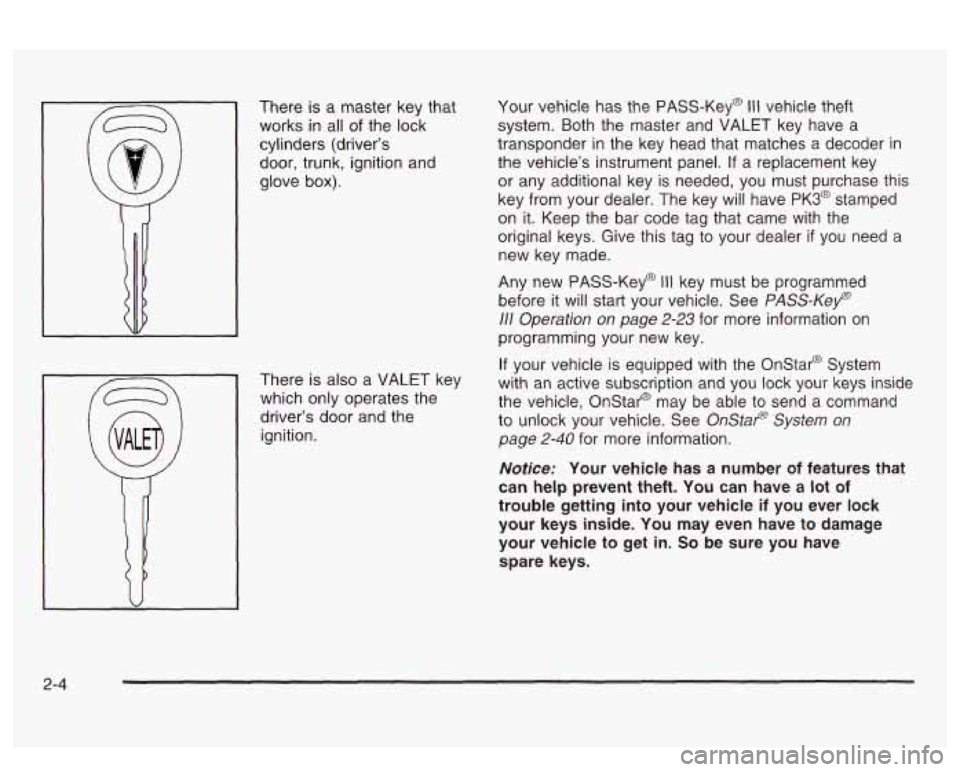
There is a master key that
works in all of the lock
cylinders (driver’s door, trunk, ignition and
glove
box).
There is also a VALET key
which only operates the
driver’s door and the
ignition. Your
vehicle has the PASS-Key@
Ill vehicle theft
system. Both the master and VALET key have a
transponder
in the key head that matches a decoder in
the vehicle’s instrument panel.
If a replacement key
or any additional key is needed, you must purchase this
key from your dealer. The key will have
PK3@ stamped
on it. Keep the bar code tag that came with the
original keys. Give this tag to your dealer
if you need a
new key made.
Any new PASS-Key@
Ill key must be programmed
before it will start your vehicle. See
PASS-Kef)
111 Operation on page 2-23 for more information on
programming your new key.
If your vehicle is equipped with the Onstar@ System
with an active subscription and you lock your keys inside
the vehicle, Onstar@ may be able to send a command
to unlock your vehicle. See
OnStap System on
page
2-40 for more information.
Notice: Your vehicle has a number of features that
can help prevent theft. You can have a lot of
trouble getting into your vehicle
if you ever lock
your keys inside. You may even have to damage
your vehicle to get in.
So be sure you have
spare keys.
2-4
Page 70 of 418
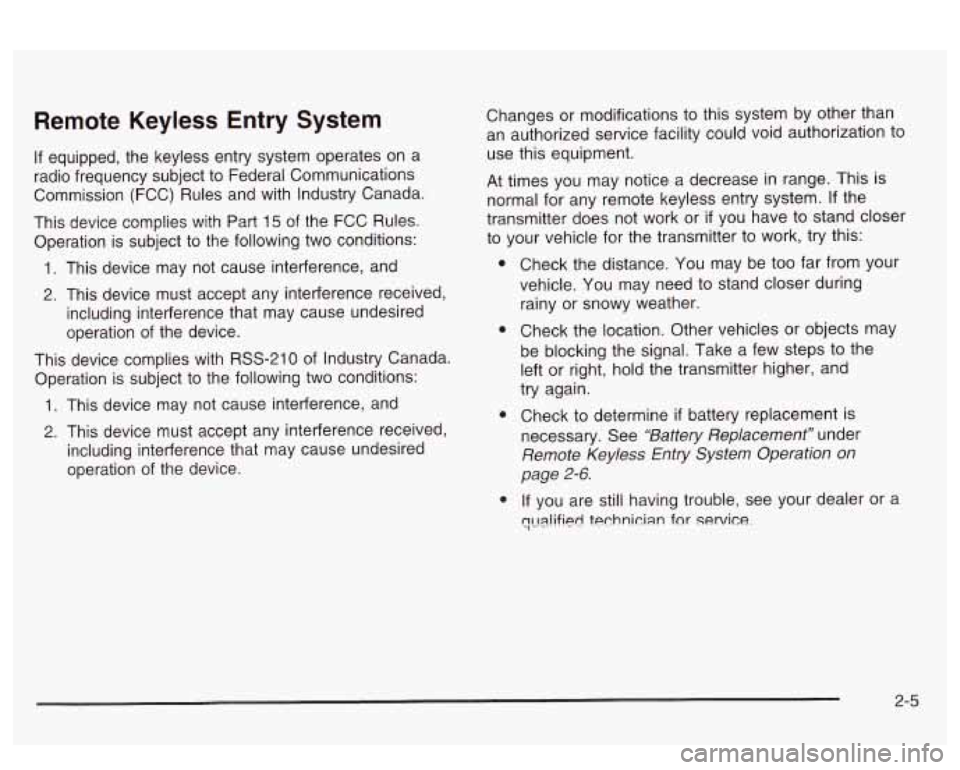
Remote Keyless Entry System
If equipped, the keyless entry system operates on a
radio frequency subject to Federal Communications
Commission (FCC) Rules and with Industry Canada.
This device complies with Part 15 of the FCC Rules.
Operation is subject to the following two conditions:
1. This device may not cause interference, and
2. This device must accept any interference received,
including interference that may cause undesired
operation of the device.
This device complies with RSS-210 of Industry Canada.
Operation is subject to the following two conditions:
1. This device may not cause interference, and
2. This device must accept any interference received,
including interference that may cause undesired
operation of the device. Changes
or modifications to this system by other than
an authorized service facility could void authorization to
use this equipment.
At times you may notice a decrease in range. This is
normal for any remote keyless entry system.
If the
transmitter does not work or
if you have to stand closer
to your vehicle for the transmitter to work, try this:
e
e
Check the distance. You may be too far from your
vehicle. You may need to stand closer during
rainy or snowy weather.
Check the location. Other vehicles or objects may
be blocking the signal. Take a few steps to the
left or right, hold the transmitter higher, and
try again.
Check to determine if battery replacement is
necessary. See
“Battery Replacement” under
Remote Keyless Entry System Operation on
page
2-6.
If you are still having trouble, see your dealer or a
q~Ia!ified technician for service.
2-5